
Vickers VC10 Engine Installation
Rolls-Royce Conway 42 Engines
| Drawings Courtesy of Bruce Vander Mark |
VC10 Nacelle Structure
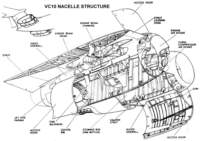 |
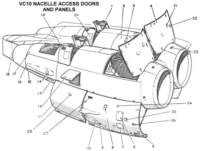 |
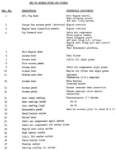 |
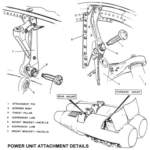 |
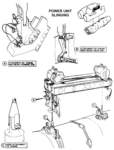 |
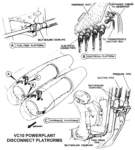 |
Each pair of nacelles is suspended from a torque box made up of curved front and rear beams (or spars), ribs and top/bottom skin with stringers. Fuselage cross beams are extended by the front and rear nacelle beams which are bolted to them.
A complete box structure is made by skinning the upper and lower surfaces of the beams.
Nacelles are formed by inner and outer sidewalls and a centre rib. Forward extensions of ribs 1 and 3, and the outer side wall carry the double intake fairings for two engines, whilst rearward extensions carry a fireproof bulkhead. Between the engine intakes is a single intake for the cabin compressor. The strut, which is streamline in cross section, is built around a centre structure that is a continuation of the nacelle torque box.
Access to the top of an engine is provided by hinged doors (hinge pip pins allow complete removal), removable stressed panels, and holes and small accesses. Access to the bottom of an engine is provided by two doors at the bottom of each nacelle that hinge away from rib 3 and expose the engine from the nacelle intake to the fireproof bulkhead. Each has three hinges, one being adjustable for door rigging. Behind the fireproof bulkhead a removable double fairing, which covers the jet pipe and thrust reverser, is attached to mounting rings on each engine and jet pipe.
The front and rear beams of the torque box each carry fittings for attachment of the engine support links. Engines are attached by tapered sleeves and bolts. A drag fitting on the front beam of the torque box accommodates the engine thrust pillar. The engine attachment fittings on the front and rear torque box beams also have provision for fitting a hoist for use when changing engines, thrust reversers, and jet pipes.
Constant Speed Drive (CSD)
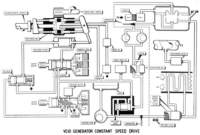 |
 |
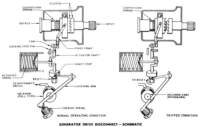 |
The CSD serves to drive the generators at a constant speed of 6,000 rpm in spite of varying engine speeds and also to synchronize them so that their outputs are in phase. The CSD is driven by gearing from the HP compressor via a disconnect unit and a universal joint. It is mounted under the LP compressor casing on the left side of the engine; the generator is bolted to its front face.
Drive is transmitted through a hydraulic pump and a hydraulic motor, each of the "wobble-plate" type. The "input" from the engine drives the pump, and the "output" to the generator is from the motor. A servo-piston can vary the delivery of the pump by altering the angle of the wobble plate; this in turn varies the rpm of the motor relative to the rpm of the pump. If the pump wobble plate angle is increased, the delivery of the pump is increased and output rpm will increase relative to input rpm, and vice versa.
If output rpm are above 6,000, the opposite will take place and rpm will return to 6,000.
Generators operating in parallel have a natural tendency to remain in phase. However, if the load on individual generators varies, they will move out of phase. Magnetic Trim is fitted to keep the generators in phase and therefore their loads equal. The Magnetic Trim is an electro-magnet which can be made to attract or repel the fly-weights in the speed governor, which are themselves permanent magnets. It can therefore bias the setting of the governor and cause the output rpm to change. If the generator does move out of phase, a signal is sent to the magnetic trim to slightly speed up or slow down the generator and bring it back into synchronization.
Oil for the operation of the CSD and its lubrication is supplied from a tank on the port side of the engine. The CSD has two pressure or "charge" pumps and one scavenge pump. The circulation is completed back to the tank via an oil cooler employing "ram air" as the cooling medium and a thermostatic by-pass valve. A bank of "jet-pumps" in the outlet from the cooler provides ground cooling. The oil system is self contained, and though using oil of the same type as the engine, has no connection with it. A pressure filter and a sight gauge are accessible through an access panel in the lower front cowling. The oil tank and the CSD are both pressurized with P.2. air tapped from the engine, to prevent aeration.
A Disconnect Unit allows the CSD to be disconnected from the engine in case of malfunction. The disconnect unit is bolted to the engine and contains dogs that drive the CSD A disconnect switch on the engineer's electrical panel operates a solenoid in the disconnect unit which withdraws a pin and allows a large spring to disengage the dogs. The CSD can only be re-connected on the ground, requiring a manual operation at the disconnect unit itself.
Thrust Reversers
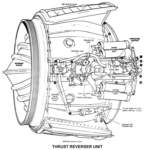 |
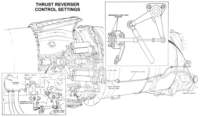 |
 |
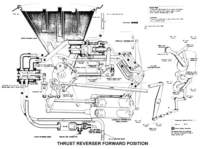 |
 |
A thrust reverser mounted on the rear of the outboard engines provides a means of reducing aircraft forward speed by reversing the direction of the exhaust gas flow and therefore engine thrust.
The reverser consists of two doors or eyelids, hinged about the horizontal axis, which in the normal or "forward thrust" position form part of the jet pipe inner casing and for "reverse" pivot rearwards to blank off the exit nozzle and uncover outlet ports at the top and the bottom of the unit. Cascade vanes in the top outlet deflect the gases forward at 45° while in the bottom outlet the outer vanes deflect the gases forwards at 30° and outwards at 35°, and the inner vanes deflect the gases backwards at 15° and inwards at 20°. This arrangement prevents ingestion of hot gas or debris into the engine intakes.
Individual amber warning lights mounted on the pilots centre instrument panel and repeated on the engineer's engine panel are illuminated whenever the reverser lock is broken.